



Examples of applications
Study of geological sections by the RAP method
The surveys conducted under a contract with the Department
of Transportation in Ohio, can illustrate the advantages of the RAP method for geological
setting studies. Measurements were carried out along a number of lines, one of which is
shown in the Figure. One of the problems the construction firms often face in Ohio is
the wide development of coal seams in this state.
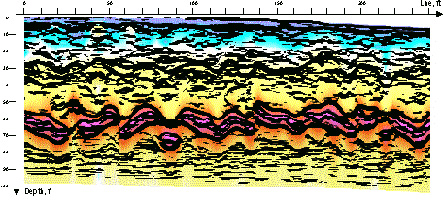 As a result, the subsidence of the soil, on which construction is being carried out,
is a frequent case here. The major objectives of the RAP-method surveys were to map
the coal seams, to determine the groundwater level and identify geological features
of the section. The RAP instrument coped perfectly with all the tasks. The coal
seams were located at a depth of 28 to 40 feet and traced over the whole length
of the line. At a depth of 60 feet, an aquifer was revealed to be underlain by
clay sediments. Below the 70 feet level we detected a boundary indicative of a
new rock layer. This can be clearly seen from the sharp change in the layering
structure of the geomechanical section of area under study.
As a result, the subsidence of the soil, on which construction is being carried out,
is a frequent case here. The major objectives of the RAP-method surveys were to map
the coal seams, to determine the groundwater level and identify geological features
of the section. The RAP instrument coped perfectly with all the tasks. The coal
seams were located at a depth of 28 to 40 feet and traced over the whole length
of the line. At a depth of 60 feet, an aquifer was revealed to be underlain by
clay sediments. Below the 70 feet level we detected a boundary indicative of a
new rock layer. This can be clearly seen from the sharp change in the layering
structure of the geomechanical section of area under study.
Mapping of kimberlyte pipes
This experimental work, carried out by the RAP method and applied to searching for exposed pipes, took place in Archangel province and in the Ukrainian Shield ( Priazovski Massif).
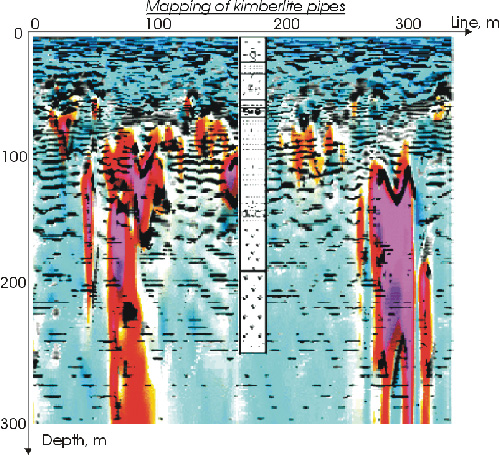
Mapping of the water- carrying soil layers
A horizontal water-carrying layer was surveyed and mapped as shows in Figure. Chemical waste leakage from a storage tank was detected.

Subsurface survey in preparation for construction
Figure shows a subsurface profile of a site where construction of a pipeline at the dept of 20 meters was planned. The survey was done to ensure the most suitable selection of the pipeline path. Various soil layers are identified in the picture.
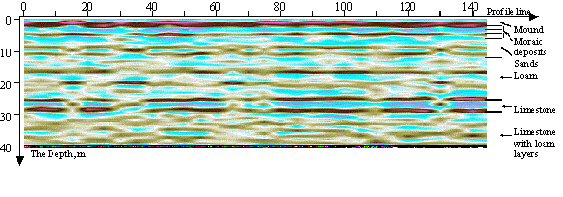
Mapping of tectonic disturbances
Figure clearly depicts tectonic disturbances (red color).
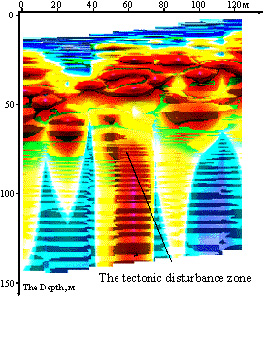
Search for Tanks Containing Radioactive Wastes
The search for radioactive wastes was carried out in St. Petersburg in 1996. Despite the small number of points at which measurements were made for a given distance at the location of the wastes, seven tanks filled with radioactive liquid were located at a depth of 2.5 m (see picture). The results of the carried out work allowed for significantly accelerating the deactivation of these discovered waste tanks. The tanks were made of a material which was not ferro-magnetic but concrete plus other non-ferro-magnetic materials, and those tanks were located in the center of St. Petersburg where the high level of noise and congestion would make it extremely difficult to use the background art methods.
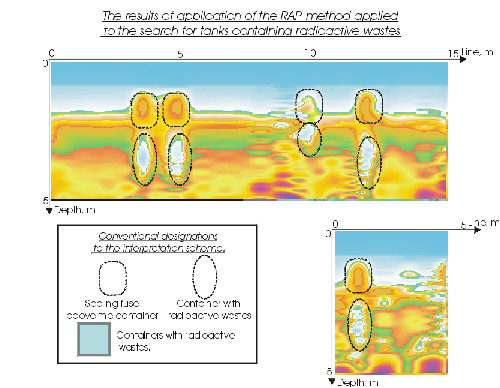
Surveying for filtration zones in dams
The dam of one of the water reservoirs of the Petrodvoretz (Russia) fountain supply system was broken and needed reconstruction. The dam was also to be searched for leakages that could cause new accidents. RAP equipment was used to carry out measurements along the dam embankment and resulted in the identification of hazardous zones (see Figure). They survey also helped to determine the necessary extent of reconstruction and improved the reconstruction strategy.
